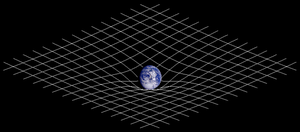This is an old revision of this page, as edited by BenRG (talk | contribs) at 22:00, 19 October 2007 (Revert - it was correct before ("lower" in the sense of numerically less than)). The present address (URL) is a permanent link to this revision, which may differ significantly from the current revision.
Revision as of 22:00, 19 October 2007 by BenRG (talk | contribs) (Revert - it was correct before ("lower" in the sense of numerically less than))(diff) ← Previous revision | Latest revision (diff) | Newer revision → (diff)

The theory of relativity, or simply relativity, refers specifically to two theories: Albert Einstein's special relativity and general relativity.
The term "relativity" was coined by Max Planck in 1908 to emphasize how special relativity (and later, general relativity) uses the principle of relativity.
Special relativity
Main article: Special relativitySpecial relativity is a theory of the structure of spacetime. It was introduced in Albert Einstein's 1905 paper "On the Electrodynamics of Moving Bodies". Special relativity is based on two postulates which are contradictory in classical mechanics:
- The laws of physics are the same for all observers in uniform motion relative to one another (Galileo's principle of relativity),
- The speed of light in a vacuum is the same for all observers, regardless of their relative motion or of the motion of the source of the light.
The resultant theory has many surprising consequences. Some of these are:
- Time dilation: Moving clocks tick slower than an observer's "stationary" clock.
- Length contraction: Objects are observed to be shortened in the direction that they are moving with respect to the observer.
- Relativity of simultaneity: two events that appear simultaneous to an observer A will not be simultaneous to an observer B if B is moving with respect to A.
- Mass-energy equivalence: E = mc², energy and mass are equivalent and transmutable.
The defining feature of special relativity is the replacement of the Galilean transformations of classical mechanics by the Lorentz transformations. (See Maxwell's equations of electromagnetism and introduction to special relativity).
General relativity
Main article: General relativityGeneral relativity is a theory of gravitation developed by Einstein in the years 1907–1915. The development of general relativity began with the equivalence principle, under which the states of accelerated motion and being at rest in a gravitational field (for example when standing on the surface of the Earth) are physically identical. The upshot of this is that free fall is inertial motion: In other words an object in free fall is falling because that is how objects move when there is no force being exerted on them, instead of this being due to the force of gravity as is the case in classical mechanics. This is incompatible with classical mechanics and special relativity because in those theories inertially moving objects cannot accelerate with respect to each other, but objects in free fall do so. To resolve this difficulty Einstein first proposed that spacetime is curved. In 1915, he devised the Einstein field equations which relate the curvature of spacetime with the mass, energy, and momentum within it.
Some of the consequences of general relativity are:
- Time goes slower at lower gravitational potentials. This is called gravitational time dilation.
- Orbits precess in a way unexpected in Newton's theory of gravity. (This has been observed in the orbit of Mercury and in binary pulsars).
- Even rays of light (which are weightless) bend in the presence of a gravitational field.
- The Universe is expanding, and the far parts of it are moving away from us faster than the speed of light. This does not contradict the theory of special relativity, since it is space itself that is expanding.
- Frame-dragging, in which a rotating mass "drags along" the space time around it.
Technically, general relativity is a metric theory of gravitation whose defining feature is its use of the Einstein field equations. The solutions of the field equations are metric tensors which define the topology of the spacetime and how objects move intertially.
References and links
See the special relativity references and the general relativity references. For information on the silent film produced on this subject, see The Einstein Theory of Relativity.
External links
- Wikibooks: Special Relativity
- Relativity Animations
- Relativity tutorial
- Living Reviews in Relativity — An open access, peer-referred, solely online physics journal publishing invited reviews covering all areas of relativity research.
- MathPages - Reflections on Relativity — A complete online course on Relativity.
- Relativity explained in words of four letters or less
- On the Electrodynamics of Moving Bodies
- Special Relativity Simulator
- A Relativity Tutorial at Caltech — A basic introduction to concepts of Special and General Relativity, as well as astrophysics.
- Relativity Gravity and Cosmology — A short course offered at MIT.
- Relativity in film clips and animations from the University of New South Wales.
- Animation easy to understand Animation for Pirelli Ralativity Award.
- What is the experimental basis of Special Relativity?
Template:Link FA Template:Link FA
Categories: